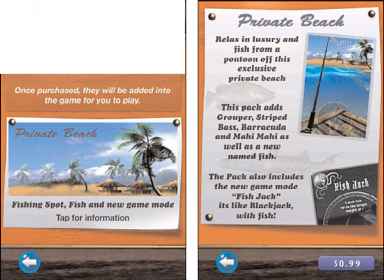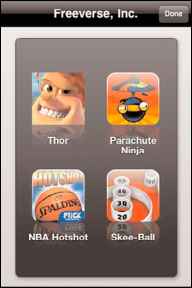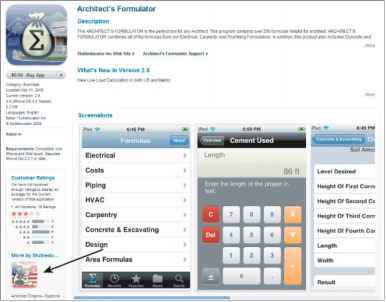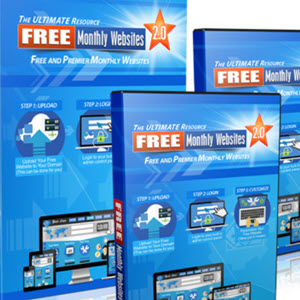Cross Selling and UpSelling
Cross-selling is offering your buyer another product that is complementary to what you are already selling. In the app world, this is offering the app buyer another app or pack to whatever they have already bought. Amazon perfected this approach by displaying other items that similar buyers have purchased along with the item being displayed. This marketing approach has dramatically lifted sales for Amazon across its entire website.
Apple, perhaps taking a cue from Amazon, also includes the icons for similar apps purchased at the bottom of an App's page. The App Store is helping you out by displaying your app along with other apps when someone does a search on the App Store for a particular type of app. Depending on how many similar apps there are, your app could be displayed frequently when someone does a search for the same type of app. An example of a financial app with other recommended/similar apps is shown in Figure 16.2.
Every customer is a valuable asset for you. For certain apps, you can create additional add-on packs for your app. For example, Figure 16.3 shows a popular app that has both a free and a paid version. In the free version, there is an announcement at the bottom of the app inviting you to purchase and download the paid app instantly through the iPhone/iPad. This is an example of up-selling the app buyer from a less expensive (free) app to the paid version of the app.
Customers Also Bought
Customers Also Bought
Fauincfi Piwin« FC4-,» Ffinnei F tunee finanw Frnn«
Figure 16.2 The App Store helps your app get attention by posting similar apps at the bottom of an app's presentation page.
Fauincfi Piwin« FC4-,» Ffinnei F tunee finanw Frnn«
Figure 16.2 The App Store helps your app get attention by posting similar apps at the bottom of an app's presentation page.
CHOTGLN

Figure 16.3 The Shotgun app invites the user to purchase the paid version to avoid further ads.
EKilFl U shwlho^JlD^^B
Figure 16.3 The Shotgun app invites the user to purchase the paid version to avoid further ads.
Another app that does this quite well is Freeverse's Flick Fishing. Within this app, you are given an option to purchase additional add-ons for other locations to fish. The add-on pack costs an additional $0.99. Because the game is so successful, the creators have the opportunity to capture additional revenue from the add-on pack through an impulse purchase.
A lot of times someone is playing the game and perhaps gets a little bored with the current fishing spots. So, the opportunity to buy another set of fishing holes is quite ingenious. We don't know exactly how much revenue has been derived, but it could be 25% to 50% over the base sales. That's no small amount, especially since the app has sold more than 1.4 million copies. An example of the add-on pack advertisement is shown in Figure 16.4.
Enhance the Flick Fishing experience with those sclcctcd downloadable Items.
Enhance the Flick Fishing experience with those sclcctcd downloadable Items.

- Figure 16.4 Flick Fishing's add-on pack allows buyers to make a purchase from within the app itself.
Another way to cross-sell is to provide a link to purchase other apps from within your own app. You always need to provide a screen with other apps to promote. An example of this approach using the app's menu screen to showcase other apps is shown in Figure 16.5. Some developers have formed consortiums to help each other sell the others' apps. You may also be able to work out revenue-sharing agreements where you promote other developer's apps from within your own app.
This is something you would have to arrange between fellow developers, as Apple does not provide a means to handle this type of transaction from the App Store payment perspective. However, there are other tracking means that could be employed to track where the purchase originated from. See Chapter 17, "Using iPhone/iPad Analytics," for more information on using analytics to track sales of your apps.
Although not common yet, the iPhone/iPad has made this kind of in-app cross-selling incredibly easy for the developer and easy to understand for the consumer. Don't mistake cross-selling for other forms of advertising on your app, though. You are not posting overt advertisements on your app. You simply create a menu option on your app that allows the consumer to view and purchase other apps from your company. You are not bombarding them with ads at all.
Anywhere that you can post text about your app, you should be thinking about cross-selling opportunities. In other words, you have an opportunity to cross-sell with your product website, the App Store, and the iPhone/iPad. The biggest factors

- Figure 16.5 This app also shows other apps from the same brand that the buyers can purchase directly from their iPhone/iPad. Never skip an opportunity to showcase your other products, especially when you already have a buyer running one of your apps.
in influencing the success of the cross-sell will be price and reputation. If you are selling an app for $3.99, consider selling the add-on pack for $0.99. It's an easy decision to spend another dollar when they've already spent $3.99.
If your app or brand has established a good reputation, it will also be easier to cross-sell a buyer on additional functionality or add-ons. Always be thinking about how you can market to your existing customer. It's far easier to sell them than getting a new customer. Here are some other ideas to consider as you cross-sell your app:
• Cross-sell on your product website and within the App Store—Use some space on the App Store text to mention your other apps. At the bottom of your verbiage, you can put a note for buyers to check out your other apps as well. Be sure to do the same thing on your website. For each product displayed, be sure to show other app icons to the right or left of the screen displaying the other apps you have for sale.
The App Store also helps you out with cross-selling by showcasing other apps you have for sale on the lower-left side of your app's display. This is a big advantage that the App Store provides to help you cross-sell or up-sell your customers to other apps you have written.
An example of the App Store showcasing a paid app is shown in Figure 16.6, along with the other apps this same company/developer has for sale. Keep in mind that if a buyer clicks on a paid app, and a free app is also offered from the same company/developer, the free app is also shown at the bottom of the page.

- Figure 16.6 An app is displayed on the main screen while other apps are shown below as additional options for the buyer.
• Cross-sell to build your brand—If you are looking for way to build your brand, you can always sell other items on your website such as mugs, caps, or T-shirts with your company's logo or app icon. Are you going to make tons of money doing this? No! But, you will help build a following for your apps and establish your brand more firmly with your buyers and site visitors.
Up-Selling
The definition of up-selling is moving someone from a less expensive product to a more expensive one. Auto dealers will advertise a less expensive car to get people to visit their showroom. Once buyers are at the dealer, the dealer shows them multiple models of cars, knowing that the chances of them buying the original car that brought them in are slim.
The most common example of up-selling with an iPhone/iPad app is when a user downloads a free app and then converts to the same paid app as mentioned earlier.
Your marketing messaging must invite the user to upgrade to your paid app. Do not assume that just because you have a free version of your app that customers will instinctively upgrade to the paid version. They need to be prompted, prodded, coerced, coached, cajoled, and invited to move over to the paid app. You can do this in the following ways:
• Prompt them within a menu screen of your free app.
• Invite them to upgrade at the bottom or top of your free app.
• Tell them that they will no longer have ads if they buy the paid app.
• Explain to them how many more features they will get with the paid app.
• Prompt them periodically within the free app to give the paid app a try.
Promotions and cross-selling should be a part of your overall app marketing plan. You can't afford not to explore these approaches when the competition for apps is so strong. Promotions, when done right, can help you increase your profits and raise your brand awareness. Another benefit of doing promotions is that they can be repeated multiple times, especially if you find success with one type of promotion over another.
Contests can be done as promotions, even on a limited budget. You can sponsor a contest where the user of your app demonstrates how they have used your app in the most creative way. You can give away cash prizes, hardware, software, T-shirts, hats, mugs, and other items. Contests will drive awareness and downloads for your app.
Cross-selling and up-selling your app buyers are other effective approaches. You can cross-sell add-on packs for your apps or subscriptions that generate additional or recurring revenue for you. Always attempt to up-sell your buyer from a free version of your app to the paid version. Do not assume that if you have a free app that your user will automatically move to a paid app. They must be invited to do so.
Do not annoy the customers by bombarding them constantly with invitations to buy your paid app. Just remember to push your paid app where appropriate in the menu page, with an icon they can click to get more information, or at the bottom of the first screen of the free app.
Continue reading here: Sets Realistic Sales Targets
Was this article helpful?
